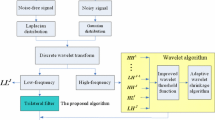Abstract
In medical Doppler ultrasound systems, a high-pass filter is commonly used to reject echoes from the vessel wall. However, this leads to the loss of the information from the low velocity blood flow. Here a spatially selective noise filtration algorithm cooperating with a threshold denoising based on wavelets coefficients is applied to estimate the wall clutter. Then the blood flow signal is extracted by subtracting the wall clutter from the mixed signal. Experiments on computer simulated signals with various clutter-to-blood power ratios indicate that this method achieves a lower mean relative error of spectrum than the high-pass filtering and other two previously published separation methods based on the recursive principle component analysis and the irregular sampling and iterative reconstruction, respectively. The method also performs well when applied to in vivo carotid signals. All results suggest that this approach can be implemented as a clutter rejection filter in Doppler ultrasound instruments.




Similar content being viewed by others
References
Hoeks AGP, van de Vorst JJW, Dabekaussen A et al (1991) An efficient algorithm to remove low frequency Doppler signals in digital Doppler systems. Ultrasound Imaging 13(2):135–144
Evans DH, McDicken WN (2000) Doppler ultrasound: physics, instrumentation and signal processing, 2nd edn. Wiley, New York
Tao Q, Wang Y, Fish P et al (2004) The wall signal removal in Doppler ultrasound systems based on recursive PCA. Ultrasound Med Biol 30(3):369–379
Tao Q, Wang Y, Wang W (2004) A new method for Doppler clutter rejection based on irregular sampling and iterative spline reconstruction. IEEE Trans Signal Process 11(9):764–767
Savery D, Cloutier G (2005) Effect of red cell clustering and anisotropy on ultrasound blood backscatter: a Monte Carlo study. IEEE Trans Ultrason Ferroelectr Freq Control 1(52):94–103
Donoho DL (1995) De-noising by soft-thresholding. IEEE Trans Inform Theory 41(3):613–627
Zhang Y, Wang Y, Wang W et al (2001) Doppler ultrasound signal denoising based on wavelet frames. IEEE Trans on Ultrason Ferroelectr Freq Control 48(3):709–716
Johnstone IM, Silverman BW (1997) Wavelet threshold estimators for data with correlated noise. J Roy Stat Soc 59:319–351
Xu Y, Weaver JB, Healy DM et al (1994) Wavelet transform domain filters: a spatially selective noise filtration technique. IEEE Trans Image Process 3(6):747–758
Pan Q, Zhang L, Dai G et al (1999) Two denoising methods by wavelet transform. IEEE Trans Signal Process 47(12):3401–3406
Zhao R, Qu H, Song G (2001) A threshold filtering algorithm based on the region relativity of the wavelet coefficients. J Xian Electron Sci Technol Univ 28(3):324–327
Bui TD, Guang YC (1998) Translation-invariant denoising using multiwavelets. IEEE Trans Signal Process 46(12):3414–3420
Coifman RR, Donoho DL (1995) Translation invariant de-noising. Lect Notes Stat 103:125–150
Nason GP, Silverman BW (1995) The stationary wavelet transform and some statistical applications. Lect Notes Stat 103:281–299
Mallat S (1989) Multifrequency channel decompositions of images and wavelet models. IEEE Trans Acoustic Speech Signal Process 37:2091–2110
Donoho DL, Johnstone IM (1994) Ideal spatial adaptation by wavelet shrinkage. Biometrika 81:425–455
Donoho DL, Johnstone IM (1995) Adapting to unknown smoothness via wavelet shrinkage. J Am Stat Assoc 90:1200–1224
Fish PJ, Bastos CAC, Vaz F (2001) Blood and wall signal simulator for Doppler ultrasound signal analysis algorithm development. Proc EMBS, Singapore, pp 135–138
Acknowledgments
This work is supported by the National Basic Research Program of China (No. 2006CB705707) and Natural Science Foundation of China (No.30570488).
Author information
Authors and Affiliations
Corresponding author
Rights and permissions
About this article
Cite this article
Jin, D., Wang, Y. Doppler ultrasound wall removal based on the spatial correlation of wavelet coefficients. Med Bio Eng Comput 45, 1105–1111 (2007). https://doi.org/10.1007/s11517-007-0240-8
Received:
Accepted:
Published:
Issue Date:
DOI: https://doi.org/10.1007/s11517-007-0240-8




